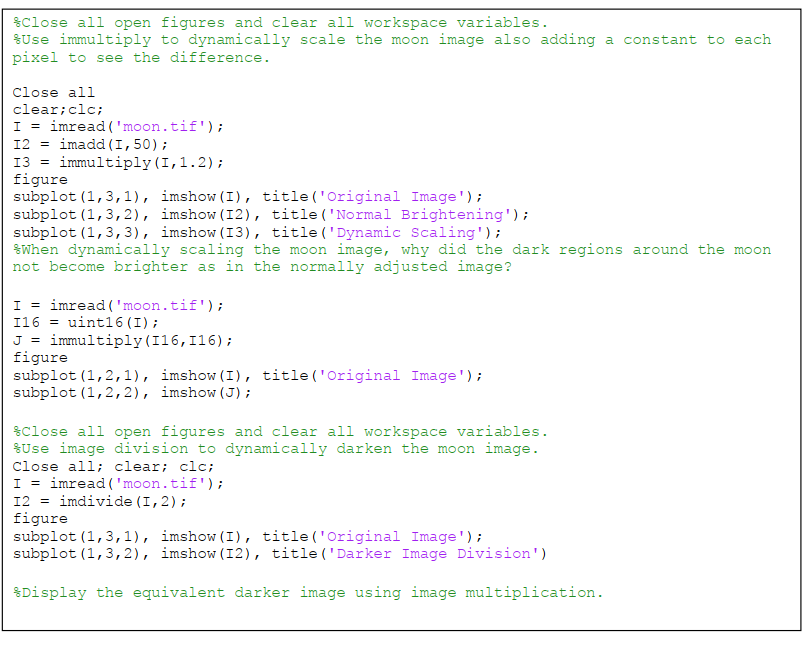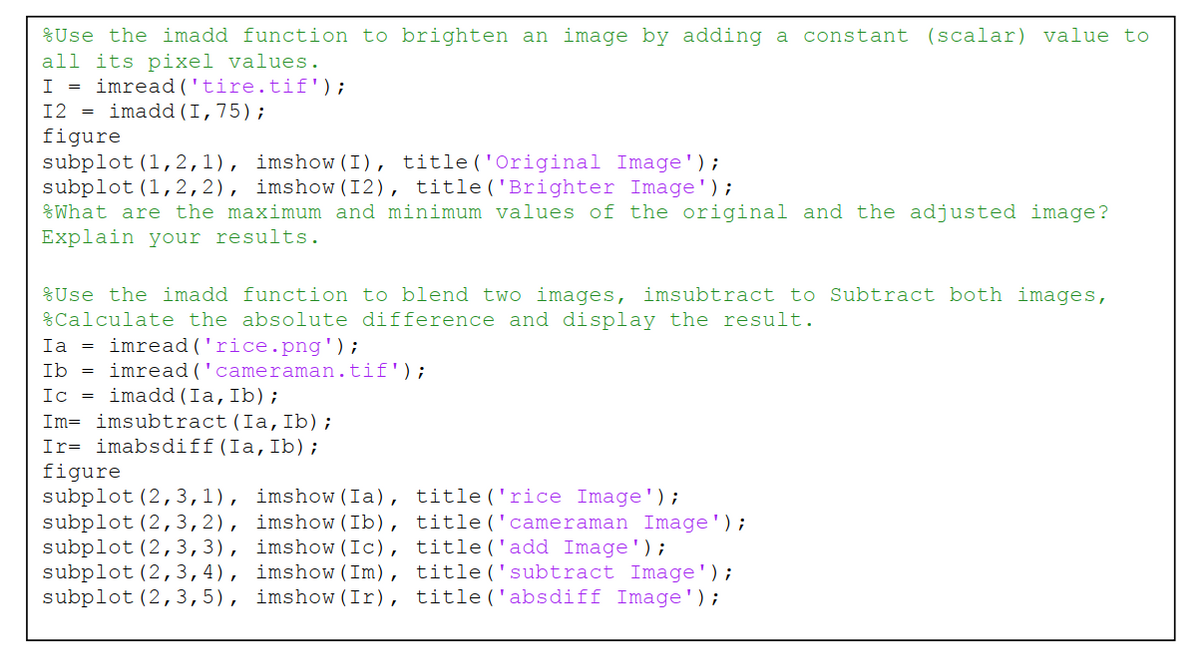What would be the result of adding a positive constant (scalar) to a monochrome image?
What would be the result of adding a positive constant (scalar) to a monochrome image?
Computer Networking: A Top-Down Approach (7th Edition)
7th Edition
ISBN:9780133594140
Author:James Kurose, Keith Ross
Publisher:James Kurose, Keith Ross
Chapter1: Computer Networks And The Internet
Section: Chapter Questions
Problem R1RQ: What is the difference between a host and an end system? List several different types of end...
Related questions
Question
What would be the result of adding a positive constant (scalar) to a monochrome image?
What would be the result of multiplying a monochrome image by a positive constant less than 1.0?

Transcribed Image Text:$Close all open figures and clear all workspace variables.
SUse immultiply to dynamically scale the moon image also adding a constant to each
pixel to see the difference.
Close all
clear;clc;
I = imread ('moon.tif');
12 = imadd (I,50);
13 = immultiply (I,1.2);
figure
subplot (1,3,1), imshow (I), title('Original Image');
subplot (1,3, 2), imshow (I2), title ('Normal Brightening');
subplot (1,3, 3), imshow (I3), title ('Dynamic Scaling');
SWhen dynamically scaling the moon image, why did the dark regions around the moon
not become brighter as in the normally adjusted image?
I = imread ( 'moon.tif');
I16 = uint16 (I);
J = immultiply(I16,I16);
figure
subplot (1,2,1), imshow (I), title('Original Image') ;
subplot (1,2,2), imshow (J) ;
$Close all open figures and clear all workspace variables.
Use image division to dynamically darken the moon image.
Close all; clear; clc;
I = imread ( 'moon.tif');
12 = imdivide (I,2);
figure
subplot (1,3,1), imshow (I), title('Original Image') ;
subplot (1,3, 2), imshow (I2), title ('Darker Image Division')
$Display the equivalent darker image using image multiplication.

Transcribed Image Text:%Use the imadd function to brighten an image by adding a constant (scalar) value to
all its pixel values.
I = imread ('tire.tif');
12 = imadd (I,75);
figure
subplot (1,2,1), imshow (I), title ('Original Image');
subplot (1,2,2), imshow (12), title ('Brighter Image');
%What are the maximum and minimum values of the original and the adjusted image?
Explain your results.
%Use the imadd function to blend two images, imsubtract to Subtract both images,
%Calculate the absolute difference and display the result.
Ia = imread('rice.png');
Ib = imread ('cameraman.tif');
Ic = imadd (Ia,Ib);
Im= imsubtract(Ia,Ib);
Ir= imabsdiff(Ia,Ib);
figure
subplot (2,3,1), imshow (Ia), title ('rice Image');
subplot (2,3,2), imshow (Ib), title('cameraman Image');
subplot (2,3,3), imshow (Ic), title('add Image');
subplot (2,3,4), imshow (Im), title ('subtract Image');
subplot (2,3,5), imshow (Ir), title ('absdiff Image');
Expert Solution
This question has been solved!
Explore an expertly crafted, step-by-step solution for a thorough understanding of key concepts.
This is a popular solution!
Trending now
This is a popular solution!
Step by step
Solved in 2 steps

Recommended textbooks for you

Computer Networking: A Top-Down Approach (7th Edi…
Computer Engineering
ISBN:
9780133594140
Author:
James Kurose, Keith Ross
Publisher:
PEARSON

Computer Organization and Design MIPS Edition, Fi…
Computer Engineering
ISBN:
9780124077263
Author:
David A. Patterson, John L. Hennessy
Publisher:
Elsevier Science

Network+ Guide to Networks (MindTap Course List)
Computer Engineering
ISBN:
9781337569330
Author:
Jill West, Tamara Dean, Jean Andrews
Publisher:
Cengage Learning

Computer Networking: A Top-Down Approach (7th Edi…
Computer Engineering
ISBN:
9780133594140
Author:
James Kurose, Keith Ross
Publisher:
PEARSON

Computer Organization and Design MIPS Edition, Fi…
Computer Engineering
ISBN:
9780124077263
Author:
David A. Patterson, John L. Hennessy
Publisher:
Elsevier Science

Network+ Guide to Networks (MindTap Course List)
Computer Engineering
ISBN:
9781337569330
Author:
Jill West, Tamara Dean, Jean Andrews
Publisher:
Cengage Learning

Concepts of Database Management
Computer Engineering
ISBN:
9781337093422
Author:
Joy L. Starks, Philip J. Pratt, Mary Z. Last
Publisher:
Cengage Learning

Prelude to Programming
Computer Engineering
ISBN:
9780133750423
Author:
VENIT, Stewart
Publisher:
Pearson Education

Sc Business Data Communications and Networking, T…
Computer Engineering
ISBN:
9781119368830
Author:
FITZGERALD
Publisher:
WILEY